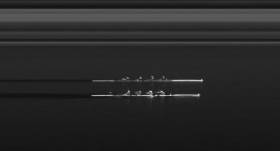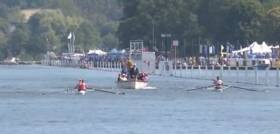Displaying items by tag: Skibbereen
Inland Fisheries Ireland (IFI) has launched an ‘all abilities’ accessible angling facility in West Cork to enable wheelchair users to fish safely and conveniently.
The bespoke €106,000 fishing platform at Shepperton Lake, 3km from Skibbereen, provides access to wheelchair users and those with reduced mobility to a section of the popular angling destination.
Up to four wheelchair anglers at a time can be accommodated at the outdoor facility which consists of a long boardwalk and a large accessible steel stand, a new picnic area and parking for six vehicles.
The initiative was co-funded by IFI and the Department of Rural and Community Development.
Speaking at the opening of the new platform, John Twomey, disheries inspector with IFI said: “The demand for accessible and safe infrastructure for wheelchair users — and those with reduced mobility — at Shepperton Lake was obvious, and we are looking forward to seeing many anglers enjoy our brand new facility.
 Deirdre Harrington with John Twomey of IFI on the new accessible angling platform
Deirdre Harrington with John Twomey of IFI on the new accessible angling platform
“We’re delighted to have had the opportunity to work with the Irish Wheelchair Association on this project and are very pleased the amenity has been constructed. We can’t wait for the new stand to open tomorrow, and for it to be used by people of all abilities.”
On Friday (31 March) IFI hosted members of the Irish Wheelchair Association in Clonakilty, Co Cork for the official opening of the new amenity, following an extensive programme of works to transform the site to support inclusive angling.
Sinéad Burke, service support officer for the Irish Wheelchair Association said: “Our service users are thrilled with the new fishing podium at Shepperton Lake and will be able to enjoy a long season of fishing from now on.
“Getting out in nature and having access to a tailor-made resource like this will be extremely beneficial to the wellbeing of our service users. We would like to thank the incredible team of IFI who went above and beyond to enhance the fishing experience of our service users. We feel very grateful to work in partnership with the team from IFI.”
IFI has collaborated with the Irish Wheelchair Association in Clonakilty for the past seven years and in that period angling day trips to Shepperton Lake have increased in popularity among the latter’s members, the organisations say.
Man Dies While Swimming in Sea Lough Near Skibbereen
RTÉ News reports that a man in his 50s has died after getting into difficulty while swimming near Skibbereen yesterday (Sunday 1 May).
It’s believed the man may have suffered a heart attack while the water in Lough Hyne around lunchtime. He was known locally as a keen swimmer and a regular in the West Cork sea lough. RTÉ News has more on the story HERE.
#Rowing: UCD won only their second senior men's eights Championship of Ireland since 1973 at the National Rowing Centre today. They last won in 2011. They had a clearwater lead by half way and never let it go.
The senior women's eight saw NUIG/Castleconnell also win well. The stern pair of Sadhbh O'Connor and Fiona Murtagh were taking their fourth titles of the weekend.
The final session of the Irish Championships started with a UCD win in the men's novice eight and continued with Ruth Morris of Commercial moving well clear to win the women's intermediate sngle sculls.
Colaiste Iognaid won a battle with Commercial in the men's junior pair, while Lee's junior women matched their junior men by winning the quadruple.
The final race of the whole event, the men's intermediate double, was won by Skibbereen.
Cork Clubs on a Run at Irish Championships
#Rowing: Cork clubs had a set of good results in the first session of Sunday finals at the Irish Rowing Championships at the National Rowing Centre.
Cork Boat Club's junior women's pair started the ball rolling, while Skibbereen then took their second title of Championships as Aodhan Burns proved a strong winner of the lightweight single sculls.
Margaret Cremen of UCC had a huge win in the lightweight single sculls, and Lee added the junior men's double to the junior quadruple title they had won on Saturday.
The tighest finish came in the men's club coxed four. NUIG made a tremendous effort to catch St Michael's of Limerick but they fell short by just .329 of a second.
Commercial of Dublin and Fermanagh's Enniskillen Royal Boat Club are having a good reatta. Enniskillen won the men's intermediate pair, while Commercial won the womens intermediate coxed four.
#Rowing: Seven different clubs won in the second session of finals on the second day of the Irish Championships. The races were run in hot sunshine.
Two women's finals senior finals were won in emphatic fashion. Georgia O'Brien of Kenmare won in the women's senior single sculls to give the club its second Championship. NUIG were also well in control in their victory in the women's senior pair.
Sadhbh Scully of Carlow, who is a junior, followed the trend in her big win in the women's club single sculls.
The women's junior 18 eights was a tighter affair, though Bann, once in the lead, held on strongly to rebuff Enniskillen.
The men's junior quadruple was a big event, with Lee taking the title ahead of Three Castles and Neptune.
Cork clubs are having a good Championships, and UCC took the women's club eights.
Skibbereen figured strongly in some finals, but had their first Championship win when Kealan Mannix won the intermediate single sculls from Shane Haugh of Castleconnell.
O'Connor and Long Race World's Best Pair at Henley
#Rowing: Grace Prendergast and Kerri Gowler, the world’s best women’s pair, beat Sadhbh O’Connor and Natalie Long of NUIG and Skibbereen in the heat of the Hambleden Pairs at Henley Royal Regatta today. The Irish women, who had qualified, saw the New Zealanders move away from them and win well.
Henley Royal Regatta, Day Three (Selected Results; Irish interest)
Hambleden Pairs (Women’s Pairs, Open): G Prendergast, K Gowler bt S O’Connor, N Long
Skibbereen Sculler Hayes Takes Her Bow at Henley
#Rowing: Orla Hayes was beaten by Jordan Lara Cole-Hossain in the Princess Royal, for open single sculls at Henley Royal Regatta today. The Thames Rowing Club sculler had a big advantage over her Skibbereen opponent down the course, and won easily.
Hayes had qualified for this tough event.
Henley Royal Regatta, Day Two (Irish interest)
Visitors (Men’s Four, Club and University): UCD bt Leander Club 2¼ l.
Fawley (Junior Men’s Quadruple): Christiana Roklub, Norway bt Enniskillen RBC 1/3 l.
Princess Royal (Women’s Single, Open): JL Cole-Hossain Orla Hayes (Skibbereen) easily
O'Driscoll and O'Donovan to Compete at Henley Royal Regatta
#Rowing: The standout names in the Irish entry for Henley Royal Regatta are Mark O’Donovan and Shane O’Driscoll. The world lightweight champions of 2017 have entered the Silver Goblets for open pairs.
The Irish challenge features Commercial in the Thames Cup for club eights and UCD’s four in the Visitors. Both crews are Irish champions. Enniskillen have chosen to enter quadruples in the Fawley and the Diamond Jubilee.
UCD, who compete at Henley Women’s Regatta this weekend, have entered the open event for women’s eights, the Remenham. Orla Hayes of Skibbereen has entered the Princess Royal, the open event for women's single scullers.
Henley Royal Regatta, July 3rd to 7th (Selection of Entries, Irish interest)
Remenham Cup (Women’s Eights, Open): UCD
Thames (Men’s Eight, Club): Commercial
Visitors (Men’s Four, Club and University): UCD
Prince of Wales (Men’s Quadruple, Club and University): Lagan Scullers’
Fawley (Men’s Quadruple, Junior): Enniskillen Royal Boat Club
Diamond Jubilee Cup (Women’s Quadruple, Junior): Enniskillen Royal Boat Club
Britannia (Men’s Fours, coxed, Club): Belfast Rowing Club
Silver Goblets (Men’s Pairs, Open): Mark O’Donovan and Shane O’Driscoll (Skibbereen)
Hambleden Pairs (Women’s Pairs, Open): Sadhbh O’Connor and Natalie Long (NUIG and Skibbereen)
Double Sculls (Men’s Double, Open): Nathan Hull and OJ Dix (Queen’s, Belfast and Leander)
Stonor Trophy (Women’s Double Sculls, Open): Fiona Chestnutt, CK Knight (Reading Univ and Newcastle Univ)
Diamond Sculls (Men’s Single, Open): Callum McCrae (Cambridge Univ Lightweight RC)
Princess Royal (Women’s Single, Open): Orla Hayes (Skibbereen)
Commercial Senior Eight Resist Strong UCD Challenge
#Rowing: Commercial beat UCD and Cork Boat Club to take the men's eights at Skibbereen Grand League Regatta at the National Rowing Centre today. Commercial seemed to be in a commanding lead coming up to the viewing area, but UCD chased them down and were under two seconds behind at the finish, with Cork not much further back.
The women's eights went, as expected, to UCC, while Holly Davis, who is just 14, won the Division Two single sculls by a huge margin.

































































